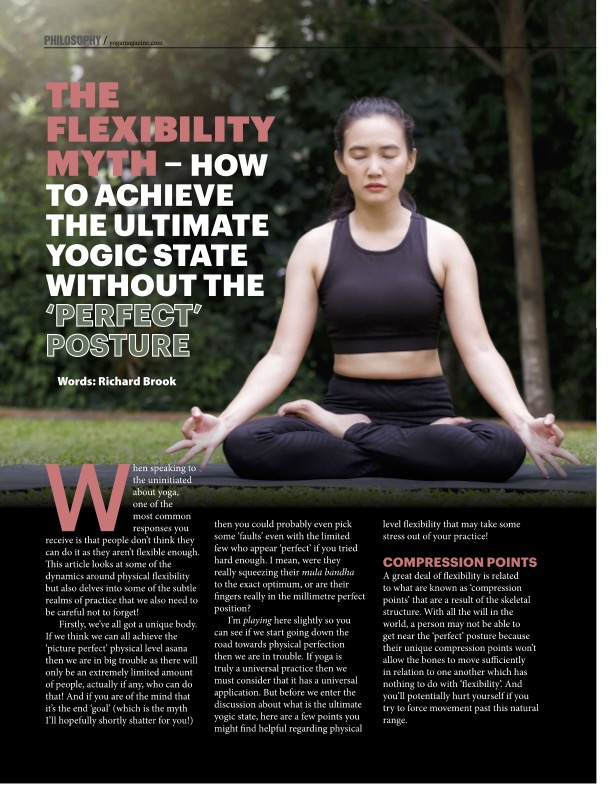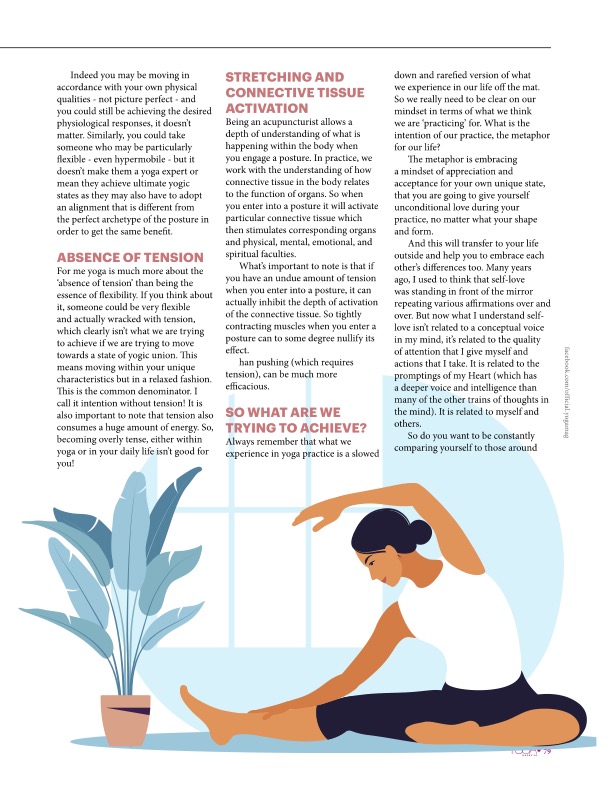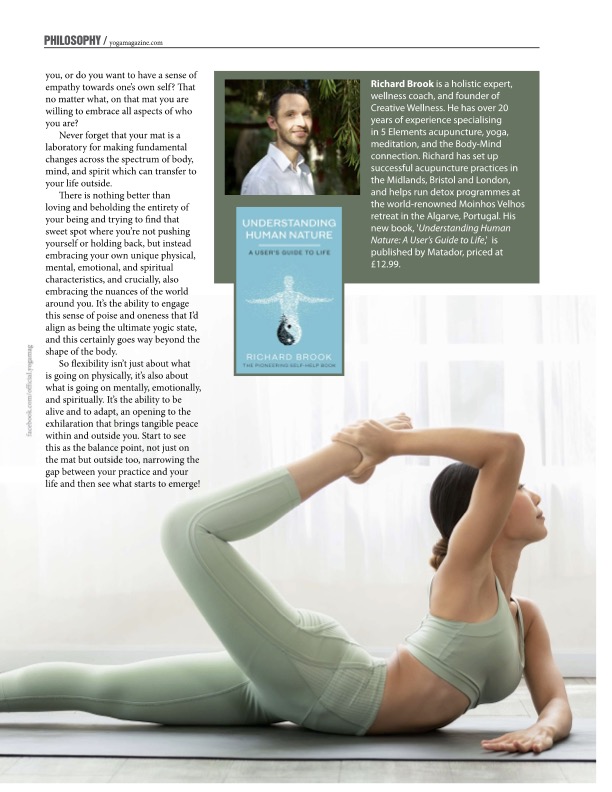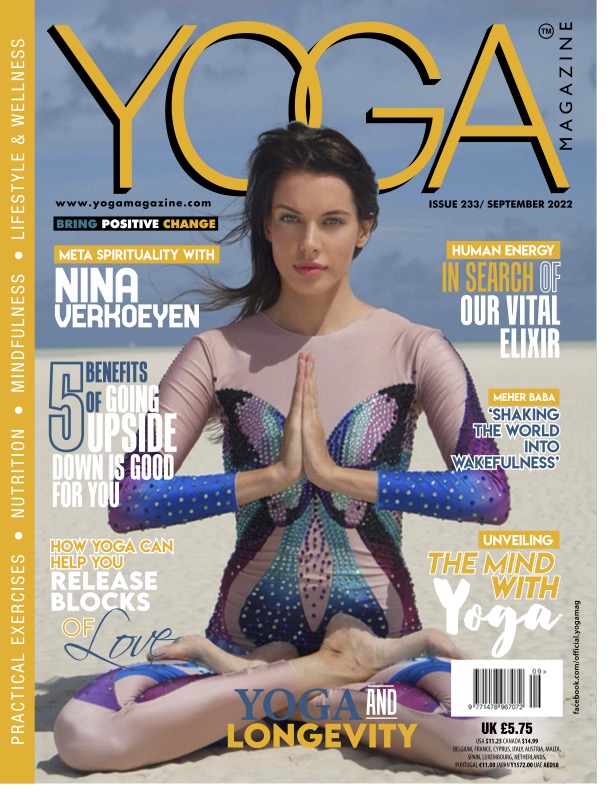In his second article for Yoga Magazine Richard explains some of the misconceptions around yoga practice and flexibity, and how it truly is a practice for everyone!
When speaking to the uninitiated about yoga one of the most common responses you receive is that people don’t think they can do it as they aren’t flexible enough. This article looks at some of the dynamics around physical flexibility but also delves into some of the subtle realms of practice that we also need to be careful not to forget!
Firstly, we’ve all got a unique body, and if we think we can all achieve the ‘picture perfect’ physical level asana then we are in big trouble as there will only be an extremely limited amount of people, actually if any, who can do that! And if you are of the mind that it’s the end ‘goal’ (which is the myth I’ll hopefully shortly shatter for you!) then you could probably even pick some ‘faults’ even with the limited few who appear ‘perfect’ if you tried hard enough. I mean, were they really squeezing their mula bhanda to the exact optimum or their fingers really in the millimetre perfect position?
I’m playing here slightly so you can see if we start going down the road towards physical perfection then we are in trouble, as if yoga is truly a universal practice then we must consider it has a universal application. But before we enter the discussion about what is the ultimate yogic state, here are a few points you might find helpful regarding physical level flexibility and take some stress out of your practice!
Compression points
A great deal of flexibility is related to what are known as ‘compression points’ that are a result of skeletal structure. With all the will in the world, a person may not be able to get near the ‘perfect’ posture because their unique compression points won’t allow the bones to move sufficiently in relation to one another which has nothing to do with ‘flexibility’. And you’ll potentially hurt yourself if you try to force movement past this natural range.
Indeed you may be moving in accordance with your own physical qualities - not picture perfect - and you could still be achieving the desired physiological responses, it doesn’t matter. Similarly, you could take someone who may be particularly flexible - even hypermobile - but it doesn’t make them a yoga expert or mean they achieve ultimate yogic states as they may also have to adopt an alignment that is different from the perfect archetype of the posture in order to get the same benefit.
Absence of tension
For me yoga is much more about the ‘absence of tension’ being the essence of flexibility. If you think about it, someone could be very flexible and actually wracked with tension, which clearly isn’t what we are trying to achieve if we are trying to move towards a state of yogic union. This means moving within your unique characteristics, but in a relaxed fashion, this is the common denominator. I call it intention without tension! It’s also important to note, that tension also consumes a huge amount of energy. So becoming overly tense, either within yoga or in your daily life isn’t good for you!
Stretching and connective tissue activation
Being an acupuncturist allows a depth of understanding of what is happening within the body when you engage a posture. In practice we work with the understanding of how connective tissue in the body relates to the function of organs. So when you enter into a posture it will activate particular connective tissue which then stimulates corresponding organs and physical, mental, emotional and spiritual faculties.
What’s important to note is that if you have an undue amount of tension when you enter into a posture, it can actually inhibit the depth of activation of the connective tissue. So tightly contracting muscles when you enter a posture can to some degree nullify its effect. Relaxing and opening, rather than pushing (which requires tension), can be much more efficacious.
So what are we trying to achieve?
Always remember that what we experience in yoga practice is a slowed down and rarefied version of what we experience in our life off the mat, so we really need to be clear on our mindset in terms of what we think we are ‘practicing’ for. What is the intention of our practice, the metaphor for our life?
The metaphor is embracing a mindset of appreciation and acceptance for your own unique state, that you are going to give yourself unconditional love during your practice, no matter what your shape and form.
And this will transfer to your life outside and help you to embrace each other’s differences too. Many years ago, I used to consider that self love was standing in front of the mirror repeating various affirmations over and over. But now what I understand as self love isn’t related to a conceptual voice in my mind, its related to the quality of attention that I give myself and actions that I take related to the promptings of my Heart (which has a deeper voice and intelligence than many of the other trains of thoughts in the mind, as we wrote about last month) related to myself and others.
So do you want to be constantly comparing yourself to those around you, or do you want to have a sense of empathy towards one’s own self, and that no matter what, on that mat you are willing to embrace all aspects of who you are?
Never forget that your mat is a laboratory for making fundamental changes across the spectrum of body, mind and spirit which can transfer to your life outside.
And there is nothing better than loving and beholding the entirety of your being and trying to find that sweet spot where you’re not pushing yourself or holding back, but instead embracing your own unique physical, mental, emotional and spiritual characteristics, and crucially, also embracing the nuances of the world around you. It’s the ability to engage this sense of poise and oneness that I’d align to as being the ultimate yogic state, and this certainly goes way beyond the shape of the body.
So flexibility isn’t just about what is going on physically it’s also about what is going on mentally, emotionally and spiritually. It’s the ability to be alive and to adapt, an opening to exhilaration which brings tangible peace within and outside you. Start to see this as the balance point not just on the mat but outside too, narrowing the gap between your practice and your life and then see what starts to emerge!




For more information please feel free to visit Richard's site, or of course book on a programme and come and meet him in person!

